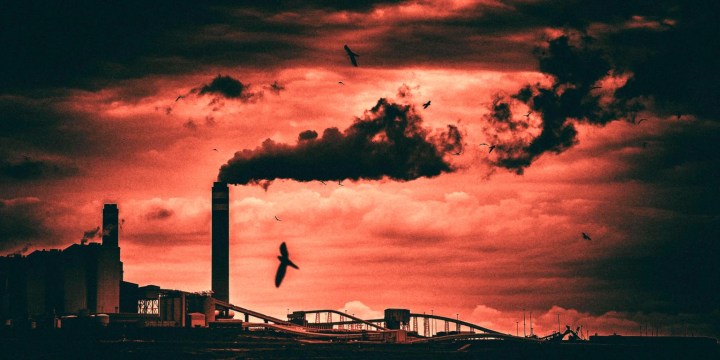TOXIC INC
Something stinks – Eskom’s uncontrolled pollution emissions cost thousands of lives and billions of rands

A lack of implementation and monitoring of sulphur dioxide emissions at Eskom power plants have caused air pollution to climb to some of the most toxic levels in the world, further threatening the health of those who breathe the polluted air.
Communities in the Mpumalanga Highveld Priority Area have long felt the health effects of Eskom’s deadly air that has caused premature deaths and health complications for the surrounding communities; particularly so among children. A recent report shows that further air quality non-compliance by the ailing power utility could result in 79,500 air pollution-related deaths from 2025 until the power plants’ end of life.
The report, Health impacts of Eskom’s non-compliance with minimum emissions standards, by the Centre for Research on Energy and Clean Air (Crea) and authored by Crea lead analyst Lauri Myllyvirta and air quality analyst Jamie Kelly, also points out that Eskom’s lack of compliance with South Africa’s Minimum Emission Standards (MES) not only costs lives, but affects the public purse too, as the lack of compliance by 2030 would be a R42-billion blow to the economy.
For Thomas Mnguni, a campaigner for groundWork living in Middelburg, Mpumalanga, the concern is not the cost to the economy, but the quality of life that he, his children and community have.
“I have two kids; a boy and a girl. Somewhere around 2010, I had to regularly take my boy to a doctor because of his asthma symptoms. I’ve just indicated to him that he must stop running 800m because he doesn’t have the breath to run 800m,” Mnguni told Our Burning Planet.
“His sister has been officially told by the school that she needs to go and check for asthma because she can’t run. So she’s only been involved in athletic events such as high jump because she can no longer run.”
Mnguni spoke to Our Burning Planet before heading out to watch his children participate in sport to witness for himself what his daughter’s teachers have told him. He is one of many parents in the region faced with the challenge of children with respiratory ailments.
Broken promises
Stretching across Gauteng and Mpumalanga, the Mpumalanga Highveld Priority Area is home to big polluters such as Sasol and Eskom. Despite South Africa having what is considered a world-class air quality control legislature, poor implementation of the National Ambient Air Quality Standards has been a hindrance to health and the environment in the area.
Compliance by Eskom could avoid as many as 140,000 asthma emergency room visits, 5,900 new cases of asthma in children, 57,000 preterm births, 35 million days of work absence and 50,000 years lived with disability, the Crea report said.
The report shows that if Eskom fully complied with the MES at all plants meant to operate beyond 2030, that would avoid about 2,300 deaths per year that are caused by air pollution. However, a lack of compliance by some industries has been blamed on the unaffordable cost of compliance technology. Other reasons have included ageing technology and water and space constraints.
Mnguni said many children’s school attendance was negatively affected by the air pollution, adding that teachers were also often absent from school because of asthma-related illnesses.
“It’s a sad story because some of the community members work in the coal sector but they also see the impacts of coal as they see how their families are suffering,” said Mnguni. “When we were putting together the Broken Promises report, we spoke to healthcare workers who had been working in Middelburg and Witbank who told us there has been a trend of seeing an increase in health issues related to asthma.”
The Broken Promises report, by the Centre for Environmental Rights with groundWork and the Highveld Environmental Justice Network, highlights the failure of the South African government to prioritise cleaning up the air in the region as promised back in 2007.
Decommissioning
Plants scheduled to be decommissioned by 2030 include the Camden, Hendrina, Arnot, Komati, Grootvlei, Kriel and Malta power stations, with newer plants such as Medupi and Kusile expected to be decommissioned by 2065 and 2069, respectively.
Decommissioning plants would help to reduce Eskom’s air pollution – a task the ailing utility has been struggling with for years, particularly with limiting the sulphur dioxide (SO2) limit.
A request by Eskom for an alternative SO2 limit was rejected, with the power plants forced to comply with the 3,500mg limit until March 2025.
Myllyvirta told Our Burning Planet: “Eskom is planning marginal improvements to fly ash emission controls, but is refusing to act on sulphur dioxide, the pollutant with by far the largest public health impacts.
“Our study aims to provide policymakers and the public [with] an appraisal of the health impacts and costs that can be avoided by requiring compliance with the standards.”
The single biggest source of SO2 is the burning of fossil fuels such as coal, gas and oil. Breathing in this chemical increases the risk of strokes, heart disease, lung cancer and premature death, according to Greenpeace.
Last year, another Crea report showed that Eskom’s SO2 levels made the power utility the top polluter in its field; more than any other energy company in the world – surpassing South Africa’s air quality safe limits.
Read more in Daily Maverick: “Eskom emits more sulphur dioxide than any power company in the world — latest research”
Deadly air
Last year, in the landmark “Deadly Air” court case, the Pretoria High Court ruled that the air pollution in Mpumalanga’s Highveld Priority Area breached residents’ constitutional right to an environment not harmful to health or wellbeing; forcing the government’s hand to ensure stakeholders such as Eskom and Sasol are held accountable.
Read more in Daily Maverick: “ ‘Deadly Air’: A case about real lives and real people”
“The Deadly Air judgment held that the section 24 right to an environment that is not harmful to health and wellbeing is immediately realisable. There is limited flexibility in the recommendations that the Forum can make to the Minister as the law is quite clear that compliance with the air pollution standards is not negotiable,” said Centre for Environmental Rights’ attorney Ntombi Maphosa in a statement.
South Africa’s MES were issued in 2010 with room for flexibility in 2015, and stricter rules and regulations were meant to be issued in 2020 that would require coal-fired power stations to install sulphur dioxide limiters. A lack of implementation and monitoring of these stringent rules has, however, seen air pollution climb to some of the most toxic levels in the world.
Mnguni said: “Currently, they say that they can’t comply because then they’d have to shut down some of the power stations and that would cause load shedding to continue. To me, it’s nonsense. They knew a long time ago that they were supposed to comply and they never did. So they cannot use the energy crisis to advance their argument on non-compliance. It’s unacceptable.”
With air pollution standards not being met, lowering emission limits became what seemed to be the next plausible move in 2020 for air quality control. For residents of the Mpumalanga Highveld Priority Area and those living near and around coal-fired power stations, lowering standards when targets aren’t met is deadly, and smells of a worsening public health emergency.
Myllyvirta said: “The current deliberations on emissions limits for Eskom likely represent the last chance to put the company on course to clean up its highly polluting coal plants. If the company has its way, many of the highest-emitting plants in the country would continue to operate without any emissions controls for sulphur dioxide for decades. Literally tens of thousands of lives are at stake.” DM/OBP




















 Become an Insider
Become an Insider
I can never understand why this aspect of the whole coal/energy issue doesn’t feature far more prominently in the ‘just transition’ debate (if we can call it that). It really is a complete no-brainer, and we cannot continue to allow Mantashe and his fellow 19th century industrialists to delay the inevitable even longer. Every day lost is lives lost and many more in pain. Instead of digging their heels in government should stand up and produce creative, innovative solutions, involving all forms of genuinely renewable sources, rejigging the transmission system to operate on a provincial or metro and local level, rather than national, and re-skilling of everyone in the coal industry. Ok we can’t expect this, or anything from government, so they should just open the door for academia, civil society and the private sector to do the creative work. It really is possible, and is increasingly and urgently necessary. We have already lost far too much time and cannot afford any more wastage.
Socialized costs and private profits. Ten’s of thousands of people dying or are seriously ill but Gwede’s buddies in the coal mining industry make the money and live far away from the problem. While (maybe) not technically criminal, certainly despicable, but they carry no shame.
South African coal has one of the lowest sulphur contents in the world.
Irrespective of that, the only practical way to remove Sulphur from the waste gas is by spraying calcium (lime) dissolved in water into the waste gas. The result is CaSo4.
Medupi and Kusile emit roughly 900 cubic meters of gas per second per boiler, so large quantities of calcium are needed.
Sulphur removal plants (scrubbers) are large and require lots of space between the ash removal plant and the chimney. This space is not present in any of the SA stations except M and K.
On top of this is the fact that they are very expensive and with all the power they use will cost Eskom and the country many many billions.
Furthermore, the large amounts of power needed results in less power which can be sent out.
Even if it could be done, the generating unit would of off for maybe a year.
It is wishful thinking to try to force Eskom to remove the SO2/SO3 from the waste gas. The country can’t afford the money nor loss of generating capacity.
The only way is to rapidly shut down the older less efficient stations and replace with green energy, or nuclear – which SA also can’t afford.